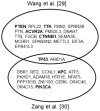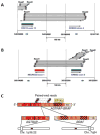Identifying molecular drivers of gastric cancer through next-generation sequencing
- PMID: 23178814
- PMCID: PMC3873853
- DOI: 10.1016/j.canlet.2012.11.029
Identifying molecular drivers of gastric cancer through next-generation sequencing
Abstract
Gastric cancer is the second most common cause of cancer-related death in the world, representing a major global health issue. The high mortality rate is largely due to the lack of effective medical treatment for advanced stages of this disease. Recently next-generation sequencing (NGS) technology has become a revolutionary tool for cancer research, and several NGS studies in gastric cancer have been published. Here we review the insights gained from these studies regarding how use NGS to elucidate the molecular basis of gastric cancer and identify potential therapeutic targets. We also discuss the challenges and future directions of such efforts.
Keywords: Gastric cancer; Gene fusion; Next-generation sequencing; RNA sequencing; Somatic mutation; Therapeutic target.
Published by Elsevier Ireland Ltd.
Conflict of interest statement
The authors declare no competing financial interests.
Figures


Similar articles
-
Microarray and next-generation sequencing to analyse gastric cancer.Asian Pac J Cancer Prev. 2014;15(19):8033-9. Asian Pac J Cancer Prev. 2014. PMID: 25338980 Review.
-
Next-generation sequencing in the clinic: promises and challenges.Cancer Lett. 2013 Nov 1;340(2):284-95. doi: 10.1016/j.canlet.2012.11.025. Epub 2012 Nov 19. Cancer Lett. 2013. PMID: 23174106 Free PMC article. Review.
-
Genomic sequencing in cancer.Cancer Lett. 2013 Nov 1;340(2):161-70. doi: 10.1016/j.canlet.2012.11.004. Epub 2012 Nov 23. Cancer Lett. 2013. PMID: 23178448 Free PMC article. Review.
-
Mutational landscape of gastric cancer and clinical application of genomic profiling based on target next-generation sequencing.J Transl Med. 2019 Jun 4;17(1):189. doi: 10.1186/s12967-019-1941-0. J Transl Med. 2019. PMID: 31164161 Free PMC article.
-
Fusion genes and their discovery using high throughput sequencing.Cancer Lett. 2013 Nov 1;340(2):192-200. doi: 10.1016/j.canlet.2013.01.011. Epub 2013 Jan 29. Cancer Lett. 2013. PMID: 23376639 Free PMC article. Review.
Cited by
-
LncRNA MT1JP functions as a ceRNA in regulating FBXW7 through competitively binding to miR-92a-3p in gastric cancer.Mol Cancer. 2018 May 2;17(1):87. doi: 10.1186/s12943-018-0829-6. Mol Cancer. 2018. PMID: 29720189 Free PMC article.
-
Dynamic monitoring of circulating tumour cells to evaluate therapeutic efficacy in advanced gastric cancer.Br J Cancer. 2016 Jan 19;114(2):138-45. doi: 10.1038/bjc.2015.417. Br J Cancer. 2016. PMID: 26784122 Free PMC article.
-
HNF4α is a therapeutic target that links AMPK to WNT signalling in early-stage gastric cancer.Gut. 2016 Jan;65(1):19-32. doi: 10.1136/gutjnl-2014-307918. Epub 2014 Nov 19. Gut. 2016. PMID: 25410163 Free PMC article.
-
High-Throughput Sequencing of Gastric Cancer Patients: Unravelling Genetic Predispositions Towards an Early-Onset Subtype.Cancers (Basel). 2020 Jul 21;12(7):1981. doi: 10.3390/cancers12071981. Cancers (Basel). 2020. PMID: 32708070 Free PMC article.
-
Decreased expression of Calpain-9 predicts unfavorable prognosis in patients with gastric cancer.Sci Rep. 2016 Jul 12;6:29604. doi: 10.1038/srep29604. Sci Rep. 2016. PMID: 27404891 Free PMC article.
References
-
- Kamangar F, Dores GM, Anderson WF. Patterns of cancer incidence, mortality, and prevalence across five continents: defining priorities to reduce cancer disparities in different geographic regions of the world. Journal of clinical oncology : official journal of the American Society of Clinical Oncology. 2006;24:2137–2150. - PubMed
-
- Ferlay Jea. CancerBase. International Agency for Research on Cancer Lyon; 2010. GLOBOCAN 2008, cancer incidence and mortality worldwide.
-
- Volk J, Parsonnet J. In: Epidemiology of Gastic Cancer and Helicobater pylori. Wang T, Fox J, Giraud A, editors. The Biology of Gastric Cancers, Springer; 2009.
-
- Parkin DM, Bray F, Ferlay J, Pisani P. Global cancer statistics, 2002. Ca-Cancer J Clin. 2005;55:74–108. - PubMed
-
- McDonald M, Hertz RP, Pitman Lowenthal SW Pfizer Facts. The Burden of Cancer in Asia. Pfizer; USA: p. 2008.
Publication types
MeSH terms
Substances
Grants and funding
LinkOut - more resources
Full Text Sources
Other Literature Sources
Medical

